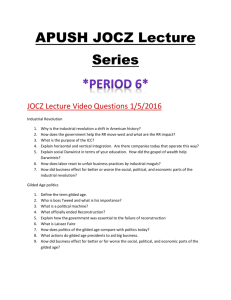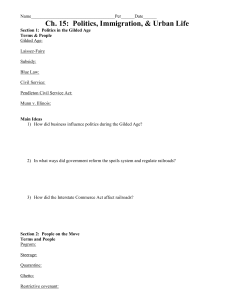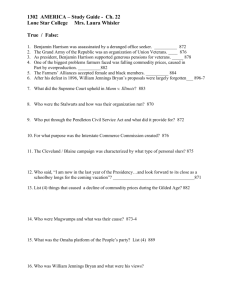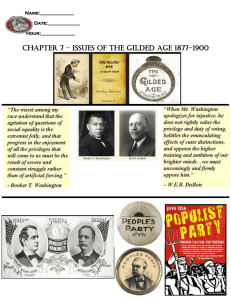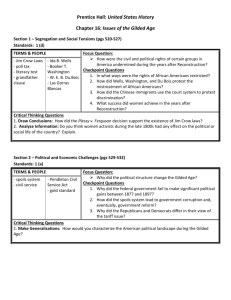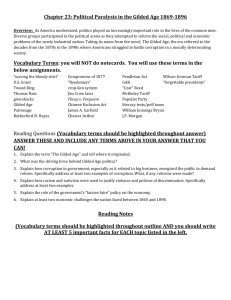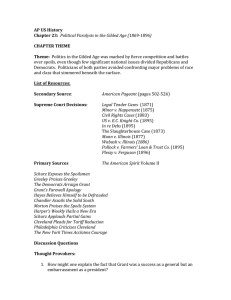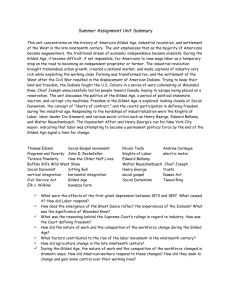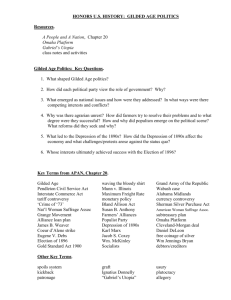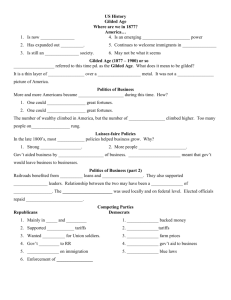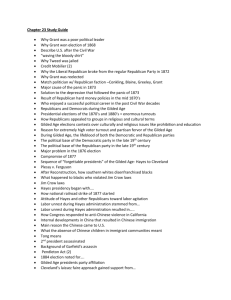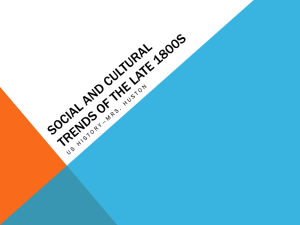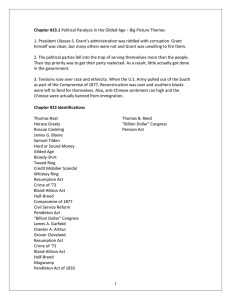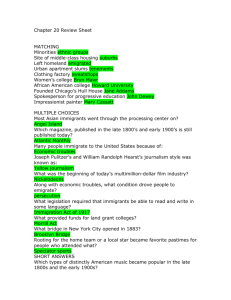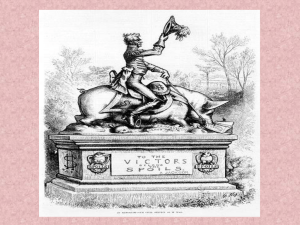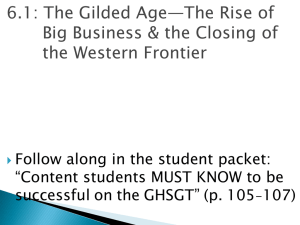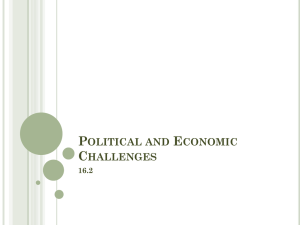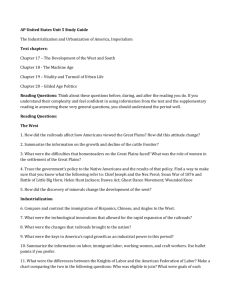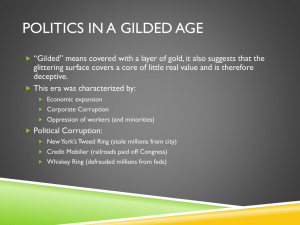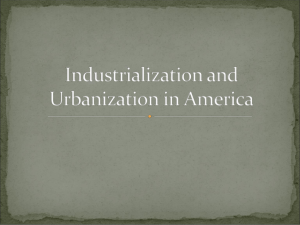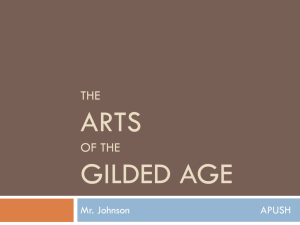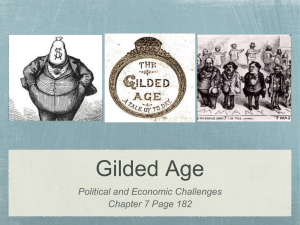unitvistudyguide-newformat.doc
advertisement
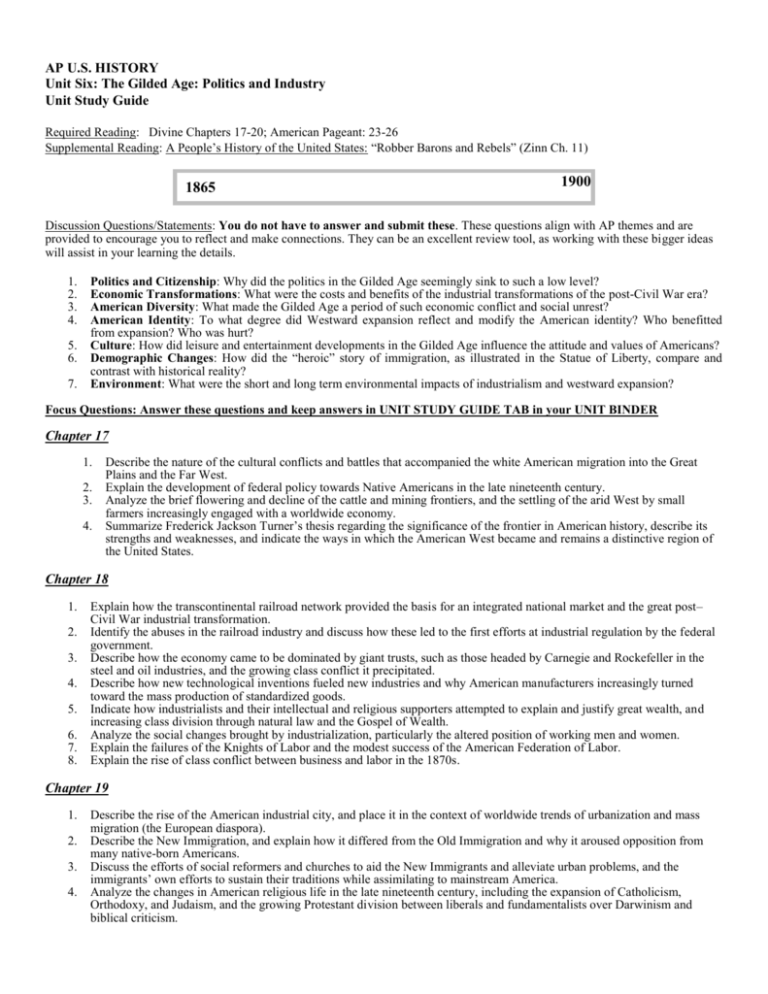
AP U.S. HISTORY Unit Six: The Gilded Age: Politics and Industry Unit Study Guide Required Reading: Divine Chapters 17-20; American Pageant: 23-26 Supplemental Reading: A People’s History of the United States: “Robber Barons and Rebels” (Zinn Ch. 11) 1865 1900 Discussion Questions/Statements: You do not have to answer and submit these. These questions align with AP themes and are provided to encourage you to reflect and make connections. They can be an excellent review tool, as working with these bigger ideas will assist in your learning the details. 1. 2. 3. 4. 5. 6. 7. Politics and Citizenship: Why did the politics in the Gilded Age seemingly sink to such a low level? Economic Transformations: What were the costs and benefits of the industrial transformations of the post-Civil War era? American Diversity: What made the Gilded Age a period of such economic conflict and social unrest? American Identity: To what degree did Westward expansion reflect and modify the American identity? Who benefitted from expansion? Who was hurt? Culture: How did leisure and entertainment developments in the Gilded Age influence the attitude and values of Americans? Demographic Changes: How did the “heroic” story of immigration, as illustrated in the Statue of Liberty, compare and contrast with historical reality? Environment: What were the short and long term environmental impacts of industrialism and westward expansion? Focus Questions: Answer these questions and keep answers in UNIT STUDY GUIDE TAB in your UNIT BINDER Chapter 17 1. 2. 3. 4. Describe the nature of the cultural conflicts and battles that accompanied the white American migration into the Great Plains and the Far West. Explain the development of federal policy towards Native Americans in the late nineteenth century. Analyze the brief flowering and decline of the cattle and mining frontiers, and the settling of the arid West by small farmers increasingly engaged with a worldwide economy. Summarize Frederick Jackson Turner’s thesis regarding the significance of the frontier in American history, describe its strengths and weaknesses, and indicate the ways in which the American West became and remains a distinctive region of the United States. Chapter 18 1. 2. 3. 4. 5. 6. 7. 8. Explain how the transcontinental railroad network provided the basis for an integrated national market and the great post– Civil War industrial transformation. Identify the abuses in the railroad industry and discuss how these led to the first efforts at industrial regulation by the federal government. Describe how the economy came to be dominated by giant trusts, such as those headed by Carnegie and Rockefeller in the steel and oil industries, and the growing class conflict it precipitated. Describe how new technological inventions fueled new industries and why American manufacturers increasingly turned toward the mass production of standardized goods. Indicate how industrialists and their intellectual and religious supporters attempted to explain and justify great wealth, and increasing class division through natural law and the Gospel of Wealth. Analyze the social changes brought by industrialization, particularly the altered position of working men and women. Explain the failures of the Knights of Labor and the modest success of the American Federation of Labor. Explain the rise of class conflict between business and labor in the 1870s. Chapter 19 1. 2. 3. 4. Describe the rise of the American industrial city, and place it in the context of worldwide trends of urbanization and mass migration (the European diaspora). Describe the New Immigration, and explain how it differed from the Old Immigration and why it aroused opposition from many native-born Americans. Discuss the efforts of social reformers and churches to aid the New Immigrants and alleviate urban problems, and the immigrants’ own efforts to sustain their traditions while assimilating to mainstream America. Analyze the changes in American religious life in the late nineteenth century, including the expansion of Catholicism, Orthodoxy, and Judaism, and the growing Protestant division between liberals and fundamentalists over Darwinism and biblical criticism. 5. Explain the changes in American education and intellectual life, including the debate between DuBois and Washington over the goals of African American education. 6. Describe the literary and cultural life of the period, including the widespread trend towards realism in art and literature, and the city beautiful movement led by urban planners. 7. Explain the growing national debates about morality in the late nineteenth century, particularly in relation to the changing roles of women and the family. Chapter 20 1. 2. 3. 4. Describe the economic forces that drove farmers into debt, and describe how the Populist Party organized to protest their oppression, attempted to forge an alliance with urban workers, and vigorously attacked the two major parties after the onset of the depression of the 1890s. Explain the economic crisis and depression of the 1890s, and indicate how the Cleveland administration failed to address it. Describe the Democratic party’s revolt against President Cleveland and the rise of the insurgent William Jennings Bryan’s free silver campaign. Explain why William McKinley proved able to defeat Bryan’s populist campaign and how the Republicans’ triumph signaled the rise of urban power and the end of the third party system in American politics. Key Terms: These must be in your UNIT BINDER which is checked the day before the unit exam. Who, what, when and why each was significant. Remember to use website I provided or you may use another source you find more helpful. “new” immigrants “old” immigrants Molly McGuires Knights of Labor National Labor Union Helen Hunt Jackson Social Gospel Gospel of Wealth Sherman Anti-trust Act social Darwinism settlement house movement horizontal integration William Jennings Bryan Battle of Little Bighorn Turner (Frontier) Thesis Gilded Age Haymarket Incident Granger Laws Henry George (Progress and Poverty) Bland-Allison Act Thomas Nast the Grange Pendleton (Civil Service) Act Boss Tweed Young Men's Christian Association Chataugua movement open range Pullman Strike Interstate Commerce Act Coxey's Army Frederick Olmstead Chinese Exclusion Act John Peter Altgeld long drives Andrew Carnegie J.P. Morgan Chief Joseph John D. Rockefeller Cross of Gold Speech Women’s Christian Temperance Union Jacob Riis (How The Other Half Lives) Populist (People's) Party American Federation of Labor A Century of Dishonor Know Nothing/American Party Dawes Act vertical integration Sioux Wars Samuel Gompers Farmer's Alliances John Dewey Sherman Silver Purchase Act Edward Bellamy Salvation Army Munn v Illinois Panic of 1873 Louis Sullivan Horatio Alger "Crime of '73" Wounded Knee Ida Wells Anti-Saloon League muckrakers Presidential Profiles 1. Rutherford B. Hayes 2. James A. Garfield 3. Chester A. Arthur 4. Grover Cleveland 5. Benjamin Harrison 6. Grover Cleveland 7. William McKinley Core Structure Sheets 1. Explain the major political and economic causes and consequences for the growth of big business in American society from 1870 to 1900. 2. Evaluate the causes which led to the agricultural changes within American society during the period from 1865 to 1900.
